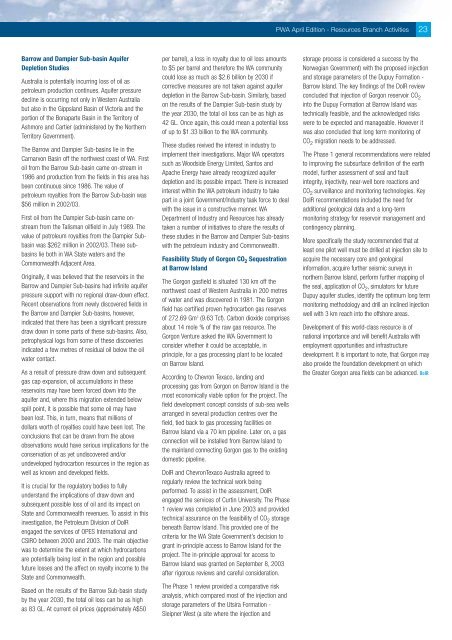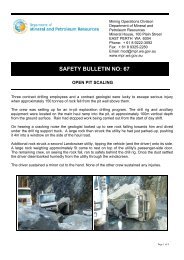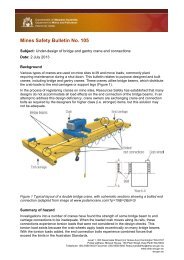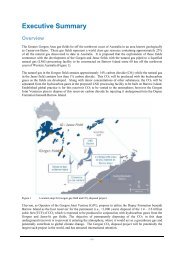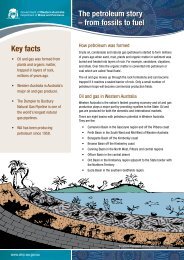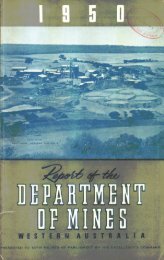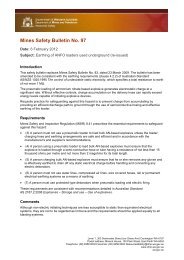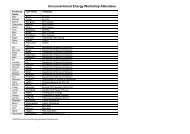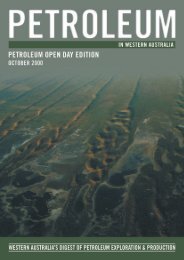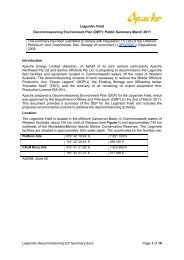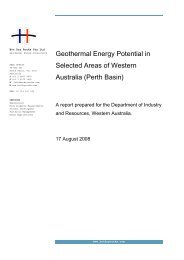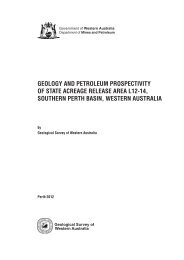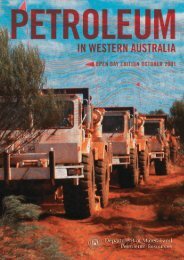IN WESTERN AUSTRALIA - Department of Mines and Petroleum
IN WESTERN AUSTRALIA - Department of Mines and Petroleum
IN WESTERN AUSTRALIA - Department of Mines and Petroleum
Create successful ePaper yourself
Turn your PDF publications into a flip-book with our unique Google optimized e-Paper software.
Barrow <strong>and</strong> Dampier Sub-basin Aquifer<br />
Depletion Studies<br />
Australia is potentially incurring loss <strong>of</strong> oil as<br />
petroleum production continues. Aquifer pressure<br />
decline is occurring not only in Western Australia<br />
but also in the Gippsl<strong>and</strong> Basin <strong>of</strong> Victoria <strong>and</strong> the<br />
portion <strong>of</strong> the Bonaparte Basin in the Territory <strong>of</strong><br />
Ashmore <strong>and</strong> Cartier (administered by the Northern<br />
Territory Government).<br />
The Barrow <strong>and</strong> Dampier Sub-basins lie in the<br />
Carnarvon Basin <strong>of</strong>f the northwest coast <strong>of</strong> WA. First<br />
oil from the Barrow Sub-basin came on-stream in<br />
1986 <strong>and</strong> production from the fields in this area has<br />
been continuous since 1986. The value <strong>of</strong><br />
petroleum royalties from the Barrow Sub-basin was<br />
$56 million in 2002/03.<br />
First oil from the Dampier Sub-basin came onstream<br />
from the Talisman oilfield in July 1989. The<br />
value <strong>of</strong> petroleum royalties from the Dampier Subbasin<br />
was $262 million in 2002/03. These subbasins<br />
lie both in WA State waters <strong>and</strong> the<br />
Commonwealth Adjacent Area.<br />
Originally, it was believed that the reservoirs in the<br />
Barrow <strong>and</strong> Dampier Sub-basins had infinite aquifer<br />
pressure support with no regional draw-down effect.<br />
Recent observations from newly discovered fields in<br />
the Barrow <strong>and</strong> Dampier Sub-basins, however,<br />
indicated that there has been a significant pressure<br />
draw down in some parts <strong>of</strong> these sub-basins. Also,<br />
petrophysical logs from some <strong>of</strong> these discoveries<br />
indicated a few metres <strong>of</strong> residual oil below the oil<br />
water contact.<br />
As a result <strong>of</strong> pressure draw down <strong>and</strong> subsequent<br />
gas cap expansion, oil accumulations in these<br />
reservoirs may have been forced down into the<br />
aquifer <strong>and</strong>, where this migration extended below<br />
spill point, it is possible that some oil may have<br />
been lost. This, in turn, means that millions <strong>of</strong><br />
dollars worth <strong>of</strong> royalties could have been lost. The<br />
conclusions that can be drawn from the above<br />
observations would have serious implications for the<br />
conservation <strong>of</strong> as yet undiscovered <strong>and</strong>/or<br />
undeveloped hydrocarbon resources in the region as<br />
well as known <strong>and</strong> developed fields.<br />
It is crucial for the regulatory bodies to fully<br />
underst<strong>and</strong> the implications <strong>of</strong> draw down <strong>and</strong><br />
subsequent possible loss <strong>of</strong> oil <strong>and</strong> its impact on<br />
State <strong>and</strong> Commonwealth revenues. To assist in this<br />
investigation, the <strong>Petroleum</strong> Division <strong>of</strong> DoIR<br />
engaged the services <strong>of</strong> OPES International <strong>and</strong><br />
CSIRO between 2000 <strong>and</strong> 2003. The main objective<br />
was to determine the extent at which hydrocarbons<br />
are potentially being lost in the region <strong>and</strong> possible<br />
future losses <strong>and</strong> the affect on royalty income to the<br />
State <strong>and</strong> Commonwealth.<br />
Based on the results <strong>of</strong> the Barrow Sub-basin study<br />
by the year 2030, the total oil loss can be as high<br />
as 83 GL. At current oil prices (approximately A$50<br />
per barrel), a loss in royalty due to oil loss amounts<br />
to $5 per barrel <strong>and</strong> therefore the WA community<br />
could lose as much as $2.6 billion by 2030 if<br />
corrective measures are not taken against aquifer<br />
depletion in the Barrow Sub-basin. Similarly, based<br />
on the results <strong>of</strong> the Dampier Sub-basin study by<br />
the year 2030, the total oil loss can be as high as<br />
42 GL. Once again, this could mean a potential loss<br />
<strong>of</strong> up to $1.33 billion to the WA community.<br />
These studies revived the interest in industry to<br />
implement their investigations. Major WA operators<br />
such as Woodside Energy Limited, Santos <strong>and</strong><br />
Apache Energy have already recognized aquifer<br />
depletion <strong>and</strong> its possible impact. There is increased<br />
interest within the WA petroleum industry to take<br />
part in a joint Government/Industry task force to deal<br />
with the issue in a constructive manner. WA<br />
<strong>Department</strong> <strong>of</strong> Industry <strong>and</strong> Resources has already<br />
taken a number <strong>of</strong> initiatives to share the results <strong>of</strong><br />
these studies in the Barrow <strong>and</strong> Dampier Sub-basins<br />
with the petroleum industry <strong>and</strong> Commonwealth.<br />
Feasibility Study <strong>of</strong> Gorgon CO 2 Sequestration<br />
at Barrow Isl<strong>and</strong><br />
The Gorgon gasfield is situated 130 km <strong>of</strong>f the<br />
northwest coast <strong>of</strong> Western Australia in 200 metres<br />
<strong>of</strong> water <strong>and</strong> was discovered in 1981. The Gorgon<br />
field has certified proven hydrocarbon gas reserves<br />
<strong>of</strong> 272.69 Gm 3 (9.63 Tcf). Carbon dioxide comprises<br />
about 14 mole % <strong>of</strong> the raw gas resource. The<br />
Gorgon Venture asked the WA Government to<br />
consider whether it could be acceptable, in<br />
principle, for a gas processing plant to be located<br />
on Barrow Isl<strong>and</strong>.<br />
According to Chevron Texaco, l<strong>and</strong>ing <strong>and</strong><br />
processing gas from Gorgon on Barrow Isl<strong>and</strong> is the<br />
most economically viable option for the project. The<br />
field development concept consists <strong>of</strong> sub-sea wells<br />
arranged in several production centres over the<br />
field, tied back to gas processing facilities on<br />
Barrow Isl<strong>and</strong> via a 70 km pipeline. Later on, a gas<br />
connection will be installed from Barrow Isl<strong>and</strong> to<br />
the mainl<strong>and</strong> connecting Gorgon gas to the existing<br />
domestic pipeline.<br />
DoIR <strong>and</strong> ChevronTexaco Australia agreed to<br />
regularly review the technical work being<br />
performed. To assist in the assessment, DoIR<br />
engaged the services <strong>of</strong> Curtin University. The Phase<br />
1 review was completed in June 2003 <strong>and</strong> provided<br />
technical assurance on the feasibility <strong>of</strong> CO 2 storage<br />
beneath Barrow Isl<strong>and</strong>. This provided one <strong>of</strong> the<br />
criteria for the WA State Government’s decision to<br />
grant in-principle access to Barrow Isl<strong>and</strong> for the<br />
project. The in-principle approval for access to<br />
Barrow Isl<strong>and</strong> was granted on September 8, 2003<br />
after rigorous reviews <strong>and</strong> careful consideration.<br />
The Phase 1 review provided a comparative risk<br />
analysis, which compared most <strong>of</strong> the injection <strong>and</strong><br />
storage parameters <strong>of</strong> the Utsira Formation -<br />
Sleipner West (a site where the injection <strong>and</strong><br />
PWA April Edition - Resources Branch Activities 23<br />
storage process is considered a success by the<br />
Norwegian Government) with the proposed injection<br />
<strong>and</strong> storage parameters <strong>of</strong> the Dupuy Formation -<br />
Barrow Isl<strong>and</strong>. The key findings <strong>of</strong> the DoIR review<br />
concluded that injection <strong>of</strong> Gorgon reservoir CO 2<br />
into the Dupuy Formation at Barrow Isl<strong>and</strong> was<br />
technically feasible, <strong>and</strong> the acknowledged risks<br />
were to be expected <strong>and</strong> manageable. However it<br />
was also concluded that long term monitoring <strong>of</strong><br />
CO 2 migration needs to be addressed.<br />
The Phase 1 general recommendations were related<br />
to improving the subsurface definition <strong>of</strong> the earth<br />
model, further assessment <strong>of</strong> seal <strong>and</strong> fault<br />
integrity, injectivity, near-well bore reactions <strong>and</strong><br />
CO 2 surveillance <strong>and</strong> monitoring technologies. Key<br />
DoIR recommendations included the need for<br />
additional geological data <strong>and</strong> a long-term<br />
monitoring strategy for reservoir management <strong>and</strong><br />
contingency planning.<br />
More specifically the study recommended that at<br />
least one pilot well must be drilled at injection site to<br />
acquire the necessary core <strong>and</strong> geological<br />
information, acquire further seismic surveys in<br />
northern Barrow Isl<strong>and</strong>, perform further mapping <strong>of</strong><br />
the seal, application <strong>of</strong> CO 2 , simulators for future<br />
Dupuy aquifer studies, identify the optimum long term<br />
monitoring methodology <strong>and</strong> drill an inclined injection<br />
well with 3 km reach into the <strong>of</strong>fshore areas.<br />
Development <strong>of</strong> this world-class resource is <strong>of</strong><br />
national importance <strong>and</strong> will benefit Australia with<br />
employment opportunities <strong>and</strong> infrastructure<br />
development. It is important to note, that Gorgon may<br />
also provide the foundation development on which<br />
the Greater Gorgon area fields can be advanced. DoIR


